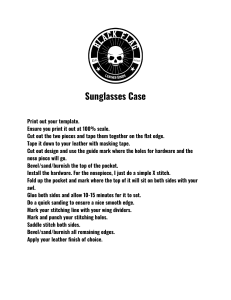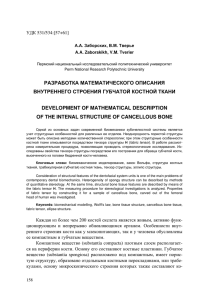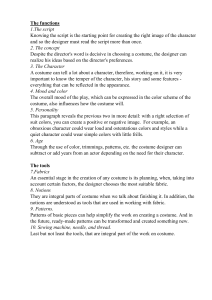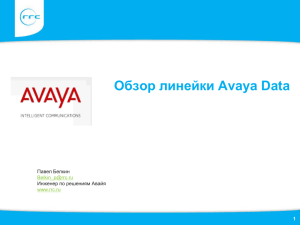
Totoro Plush a sewing pattern by totoro plush sewing tutorial Totoro Plush This pattern will show you how to make a roly-poly plush that looks just like Totoro from the famous Ghibli movie! It features a contrast belly panel with appliqued face and markings. And of course arms, ears, and a tail to bring it all together! With it, you can make a plush that resembles either the large gray Totoro, or his buddy, the smaller blue Chuu-Totoro. skills used: • Fusible web applique • Ladder stitch • Sewing curves • Gathering stitch • Basting • Darts • Sewing inner curves to outer curves difficulty: The hardest parts of this plush are likely the center belly panel (which involves some curved sewing) and all the hand sewing needed for the arms, ears, and tail. makes: One plush; body about 8” tall, 7” wide, and 6” long With extremities: 12” tall, 10” wide, and 9” long 2 sew desu ne? | www.cholyknight.com | // ©2016 Choly Knight // Items made using this pattern may be sold. Credit to “Choly Knight” or “Sew Desu Ne?” is appreciated. You may not reproduce, share, freely distribute, or sell this pattern as your own in digital or printed form. totoro plush sewing tutorial materials & tools: • 1/3 yd. of fabric for main body • 9" x 9" piece or ¼ yd. of accent fabric for belly • 3” x 3” piece of black applique fabric (felt, cotton, etc.) for pupils, whiskers, and mouth • 2" x 3-9" piece of white applique fabric (felt, cotton, etc.) for eyes and optional smile • 4” x 9” piece of light or heavy duty fusible web • sewing thread to match main fabric and applique fabrics • poly-fil stuffing • basic sewing tools (sewing machine, scissors, iron, needles, pins, fabric marker, seam ripper) suggested fabrics: faux fur minky cuddle fleece micro fleece Plush, stretchy fabrics such as fleece or minky are suggested. The variations of fleece and minky mentioned to the left would work well, but really any plushy fabric with a bit of stretch on the crosswise grain would be well-suited. Stretch fabrics like fleece or minky will create a more squat, round shape when stuffed. Non-stretchy fabrics, like felt or cotton, won’t stretch when stuffed so the resulting plush will look elongated as shown. minky vs. felt anti-pill fleece fleece 3 sew desu ne? | www.cholyknight.com | // ©2017 Choly Knight // Items made using this pattern may be sold. Credit to “Choly Knight” or “Sew Desu Ne?” is appreciated. You may not reproduce, share, freely distribute, or sell this pattern as your own in digital or printed form. totoro plush sewing tutorial printing the pattern: To print the pattern, set your computer to print pages 15-18. If you’re unfamiliar with printing and assembling a .pdf pattern, read the steps below. 1 2 3 At the print dialog box, check the box that says print at “Actual Size” or 100%. Any other selection (such as “Fit to page”) will distort the pattern so it’s slightly larger or smaller and we don’t want that. Print the pages needed for the file. You might have one or more. Either way, be sure you have the full collection by noting the page numbers in the corner. It’s likely your printer will have a margin that ensures your image doesn’t print to the very edge. Assembly will be easier if you trim off this blank margin edge. This will give you pages that overlap slightly during assembly. If you trim across the gray outline boxes, this will give you pages that don’t overlap but rather butt against each other. 4 5 To line up the pattern pages, match up the corresponding diamond shapes. Each diamond will have a letter, so it’s simply a matter of matching A1 to A2, B3 to B4 and so on. The faint gray lines indicate the border of every page, you should be able to line those up as well. When the diamond goes together, tape it in place. If you have many pages, it’s easier to tape up the pages into rows first. Then tape the rows together into a full block. You can trace the patterns onto a different paper, or you can also just cut them straight from the printer paper -- be sure that each piece is fully taped together along the joins so they don’t fall apart when you cut them. 4 sew desu ne? | www.cholyknight.com | // ©2017 Choly Knight // Items made using this pattern may be sold. Credit to “Choly Knight” or “Sew Desu Ne?” is appreciated. You may not reproduce, share, freely distribute, or sell this pattern as your own in digital or printed form. totoro plush sewing tutorial cutting the fabric: 1 2 3 4 Place pattern on the fabric, and make sure the stretch line matches the stretch of the fabric. The nap line should go in the direction of the fur. Pin the pattern in place, use pattern weights, or trace the outline of the pattern with a washable marker. Using the paper as a template, cut out the fabric. Cut the required amount according to the pattern. For all fur fabrics, shake the excess fuzz away. cutting layout: STRE TCH main body fabric NAP F D D E E D D E E C A C 1/3 yd.; 12” long F 45” wide belly fabric NAP B ¼ yd.; 9” long STRE TCH 9” wide before you begin: • Briefly read the project instructions so you know what to expect. • If desired, mark the cut fabric pieces with the markings and symbols from the pattern. Or wait until the applicable step before transferring. • Note that the seam allowance used is ¼” throughout the project. 5 sew desu ne? | www.cholyknight.com | // ©2017 Choly Knight // Items made using this pattern may be sold. Credit to “Choly Knight” or “Sew Desu Ne?” is appreciated. You may not reproduce, share, freely distribute, or sell this pattern as your own in digital or printed form. totoro plush sewing tutorial belly will be joined to front match up center notches pin notched areas together 1 . align the belly piece • Grab your Front (A) piece and Belly (B) piece. The long curve found on the inside of the front is going to be joined with the curve on the outside of the belly. • Locate the triangle notches found on the paper pattern for both the front and the belly. If you haven't already, transfer them over to the wrong side of the corresponding fabric pieces. Align the front and belly by starting with matching up these notches (right sides facing). • Place a pin through the two layers to hold the notched areas together. Next, line up the end of the front curve with the belly curve in the same manner. pin ends together, then stretch front piece to fit belly sew front to belly press seam allowances open 2. sew the belly • Stretch the front piece so it curves around the belly. Pin the curve in place as shown. Don't be afraid to use lots more pins if you're new to sewing curves. • Sew around this curve to attach the belly to the front. • If you have some puckers in your seam, you can usually get them out by ironing the piece flat. Ideally, iron it with the seam allowances open as shown for a clean, flat look to your finished plush. 6 sew desu ne? | www.cholyknight.com | // ©2017 Choly Knight // Items made using this pattern may be sold. Credit to “Choly Knight” or “Sew Desu Ne?” is appreciated. You may not reproduce, share, freely distribute, or sell this pattern as your own in digital or printed form. totoro plush sewing tutorial hold applique while pulling paper away fuse onto applique fabric trace onto paper side 3. prepare the face applique markings: blue/gray pupils/whiskers: black eyes/smile: white • Take your fusible web and trace all your applique pieces onto the smooth (paper) side. You should have 2 eyes, 2 pupils, 1 nose, 4 whiskers, 7 belly markings, and 1 optional smile. Fuse the bumpy (adhesive) side onto the wrong side of your applique fabric. • Cut out the eye pieces and arrange them on the front (A) piece of your main fabric. You can do this by setting your paper pattern on top of the fabric piece (right sides up), align the eye piece on top where the placement markings are, then carefully pull the paper pattern away while holding the applique piece in place. fuse eyes first fuse pupils & nose next fuse whiskers 4. fuse the applique • Fuse the eye pieces in place with your iron (use a press cloth -- such as a scrap piece of cotton -- if you’re using a polyester or fur fabric like minky). • Next, move onto the smaller pieces, such as the pupils and nose. Fuse them much the same way as you did the eyes, using the paper pattern and photos as a guide. • Lastly, add in the whiskers the same way as the pupils and nose. sew desu ne? | www.cholyknight.com | // ©2017 Choly Knight // Items made using this pattern may be sold. Credit to “Choly Knight” or “Sew Desu Ne?” is appreciated. You may not reproduce, share, freely distribute, or sell this pattern as your own in digital or printed form. 7 totoro plush sewing tutorial for smile: straight stitch along teeth lines in black right side of zigzag stitch lands just outside applique shape fuse belly markings 5. sew the applique • Move onto the belly area and fuse all 7 belly markings the same way you did the other features. • If you used heavy duty fusible web, you can keep the pieces fused without sewing, or you can sew them in place a number of ways. I’ve used a zigzag stitch here. →→ Refer to the next step for some other applique options. • If you've added the smile, be sure to stitch in the teeth lines. A regular straight stitch with black thread does the trick. You can also stitch over it a second time for a more pronounced line. 4 applique whipstitch straight stitch; great for felt 3 2 1 5a. other applique options Other good options for applique include a straight stitch, which involves sewing around the edge of the applique pieces with a straight stitch using matching thread -- about 1/8” in from the edge. You can also applique by hand; I prefer a whipstitch. Thread a hand-sewing needle with some matching thread and knot it. Bring the thread up from the back of the project; about 1/8” in from the edge of the applique shape. Bring it down perpendicular from the curve, just outside of the applique shape. This completes one stitch. For the next stitch, bring the needle back up about 1/8” away from the previous stitch and 1/8” in from the edge just as in the first stitch. Once again, bring it down just outside the applique shape. Continue this way until you’ve sewn around the shape. 8 sew desu ne? | www.cholyknight.com | // ©2017 Choly Knight // Items made using this pattern may be sold. Credit to “Choly Knight” or “Sew Desu Ne?” is appreciated. You may not reproduce, share, freely distribute, or sell this pattern as your own in digital or printed form. totoro plush sewing tutorial fold in half; bring together dart edges blend seam in with the fold try to match up belly seams 6. sew the front darts • The open wedges found along the top and bottom of the Front piece are the darts. Sew these by folding the front piece in half with right sides facing. Match up the diagonal edges that form the ‘legs’ of these darts. • Sew the darts by starting at the opening and moving down to the point. When sewing the point, try to blend the seam in with the fold so it makes a smooth transition and a rounder finished plush. • Repeat with the dart found at the bottom of the Front piece, again moving from the opening to the point. If possible, try to make the belly seams match up along the dart. darts: A wedge-shaped gap found in a pattern. When sewn in fabric, it creates a tuck in the fabric and develops a 3D shape. The diagonal sides of the wedge are the legs; these are matched up and sewn to the point or apex of the dart. leave opening for turning 7. sew the back pieces • Grab your two Back pieces (C). Align them together with right sides facing. • If you haven't already, locate the opening for turning markings found on the paper pattern. Transfer them over to the wrong side of the fabric. Sew along this edge of the back pieces only, but be sure to leave the opening for turning that you marked. • Open up your back piece and grab the front piece you have so far. Align them with right sides facing. Be sure the top of the back pieces (marked with a circle symbol) are aligned with the top of the front piece. sew desu ne? | www.cholyknight.com | // ©2017 Choly Knight // Items made using this pattern may be sold. Credit to “Choly Knight” or “Sew Desu Ne?” is appreciated. You may not reproduce, share, freely distribute, or sell this pattern as your own in digital or printed form. 9 totoro plush sewing tutorial stuff sides and face first, then fill out the center insert needle from inside of opening 8 . sew the front to the back • Sew around the perimeter of the body completely. Turn the body right side out through the opening you left in the back. • Stuff the body firmly with stuffing, pushing the stuffing towards the sides and face at first until the face looks full. Then finally fill in the center and back of the plush. • Once the plush is stuffed, make sure the seam allowances in the opening are tucked inside and prepare to ladder stitch it closed. Thread a hand-sewing needle and knot it at the end. Insert the needle from the inside of the opening and out of the plush near one edge of the opening. This will leave the knot inside the plush. hold thread taut while clipping bring needle out 1-2" away 9. sew the opening closed • Continue from here doing a ladder stitch. Take a 1/8” stitch into the fold of one side of the opening, then go across and take another. Keep going down the opening until you reach the end. • When you’re finished, stitch a knot into the end of the seam. Then insert the needle near the finished knot and out of the plush about 1-2” away. • Pull the thread through and hold it taut while snipping the thread. The excess thread should sink back inside the plush -- all hidden! 10 2 1 4 3 sew desu ne? | www.cholyknight.com | // ©2017 Choly Knight // Items made using this pattern may be sold. Credit to “Choly Knight” or “Sew Desu Ne?” is appreciated. You may not reproduce, share, freely distribute, or sell this pattern as your own in digital or printed form. seam allowance (folded inside) totoro plush sewing tutorial leave opening for turning 10. sew the arms • Grab your arm pieces (D). Take two of them and align them with right sides facing. • If you haven't already, locate the opening for turning markings found on the paper pattern. Transfer them over to the wrong side of the fabric. Or just leave a general ~1" mark along the side of the arm. Sew around the perimeter of the arm, leaving an opening where you just marked. • Turn the arm right side out through the opening. concentrate more of the stuffing in one end pin under-stuffed end to side of body ladder stitch closed 11. stuff and close the arms • Stuff the arms lightly with stuffing. Keep most of the stuffing towards the bottom of the arm. The end with lighter stuffing will be for attaching to the body. • Close the opening in the arm with a ladder stitch similar to what you did with the body back in step 9. Repeat with the remaining arm pieces so you have two completed arms total. • If you haven't already, locate the arm placement guidelines found on the paper pattern. Use them as a guide to pin your arm in place. The end with the lighter stuffing should be positioned there, with the more stuffed end hanging free. The flat side of the arm should be facing the body, with the seams on the sides. sew desu ne? | www.cholyknight.com | // ©2017 Choly Knight // Items made using this pattern may be sold. Credit to “Choly Knight” or “Sew Desu Ne?” is appreciated. You may not reproduce, share, freely distribute, or sell this pattern as your own in digital or printed form. 11 totoro plush sewing tutorial flip arm up and stitch across stitch around 'shoulder' first 12. attach the arms • Stitch the arm in place with a ladder stitch much like you did back in step 9. Start by going around the rounded end of the arm (now technically the 'shoulder'). • Once you get to the straight side, flip the arm up and sew across the underside of the arm. • Repeat with the other arm on the other side of the body. clip seam allowance near curves 13. sew the ears leave open for turning • Grab your Ear pieces (E). Take two of them and align them with right sides facing and edges matching up. • Sew the two together around the long curved edge, leaving the short straight edge free for turning right side out later. • Clip the seam allowances around the curves near the bottom of the ear. This will increase flexibility when the ear is turned later. 12 sew desu ne? | www.cholyknight.com | // ©2017 Choly Knight // Items made using this pattern may be sold. Credit to “Choly Knight” or “Sew Desu Ne?” is appreciated. You may not reproduce, share, freely distribute, or sell this pattern as your own in digital or printed form. totoro plush sewing tutorial stuff until ear takes shape stitch around opening of ear pull at thread to cinch up opening 14. stuff and close the ears • Stuff the ear lightly with stuffing; just enough so it takes shape. • Thread a hand-sewing needle and knot the end. Run a gathering stitch around the opening of the ear. • Pull at the thread to cinch the ear closed. Tuck in the fabric edges so nothing is poking out. gathering: The process of shortening the length of a piece of fabric by sewing long stitches through it. When the thread is pulled, it forms small folds that ruffle the fabric. gathering stitch: A long version of the running stitch, which is a stitch done by weaving the needle in and out of a length of fabric going along a line. The long stitches (about ¼”-½” long) gather the fabric when pulled later. short end points to center long end points outside stitch around base of ear 15. attach the ears • Position the ear so the side seams line up with the side seams of the body. →→ Note that the bottom of the ear is at an angle. The longer end should be pointed toward the outside of the body. This is so the ear points straight up even though the head is curved. • From the front, the ear should look to be positioned right above the eyes. Or about 1¼" away from the center seam. Hold the ears in place by sticking pins down in through the base of the ear and into the body. • Ladder stitch the ears in place around the base similar to what you did with the arms. Once complete, repeat with the remaining ear on the other side of the body. sew desu ne? | www.cholyknight.com | // ©2017 Choly Knight // Items made using this pattern may be sold. Credit to “Choly Knight” or “Sew Desu Ne?” is appreciated. You may not reproduce, share, freely distribute, or sell this pattern as your own in digital or printed form. 13 totoro plush sewing tutorial leave open for turning stuff lightly with stuffing 16. sew the tail • Grab your Tail pieces (F). Align them both with right sides facing and raw edges matching up. • Sew along the long curved edge of the tail, leaving the straight edge free for turning right side out. • Turn the tail right side out and stuff it lightly with stuffing. Close up the opening of the tail the same way the ears were. Sew around the opening with a gathering stitch and pull at the thread to cinch it closed. ladder stitch tail in place align tail on back 2¾" up from bottom seam 17. attach the tail • Take the closed tail and align it on the back of your Totoro body. It's about 2¾" above the bottom seam. The cinched end should be facing the body so it's no longer seen. • Once aligned, hold the tail in place by pinning it through the base and into the body of the plush. • Finally, sew the tail in place by ladder stitching around the base much like you did with the ears. 14 congrats! this completes your plush! Now give it a big hug! sew desu ne? | www.cholyknight.com | // ©2017 Choly Knight // Items made using this pattern may be sold. Credit to “Choly Knight” or “Sew Desu Ne?” is appreciated. You may not reproduce, share, freely distribute, or sell this pattern as your own in digital or printed form. arm placement STRETCH Cut 1 from main fabric ¼” seam allowance FRONT (A) www.cholyknight.com P A T T E R N Totoro Plush applique placement arm placement pg. 1/4 A1 A2 a top d rt NAP opening for turning STRETCH ARMS (D) Cut 4 of main fabric ¼” seam allowance NAP A1 A2 STRETCH Cut 2 from main fabric ¼” seam allowance TAIL (F) www.cholyknight.com P A T T E R N Totoro Plush STRETCH EARS (E) Cut 4 of main fabric ¼” seam allowance /4 pg. 2/4 NAP A3 A4 NAP STRETCH applique placement A3 A4 P A T T E R N Cut 1 from white fabric ¼” seam allowance BELLY (B) www.cholyknight.com Totoro Plush /4 pg. 3/4 m tto o b da rt NAP op ing en fo g nin r u rt A5 A6 pg. 4/4 SMILE trace & cut 1 from white teeth lines /4 PUPILS trace & cut 2 from black EYES trace & cut 2 from white WHISKERS trace & cut 4 from black NOSE trace & cut 1 from black .c h www P A fr an Cut 2 eam allow ¼” s (C) BAoCmKmain fabcreic t.com T T nigh olyk sh u l P o Totor E R N TCH STRE NAP A5 A6 BELLY MARKING trace & cut 7 from gray or blue



